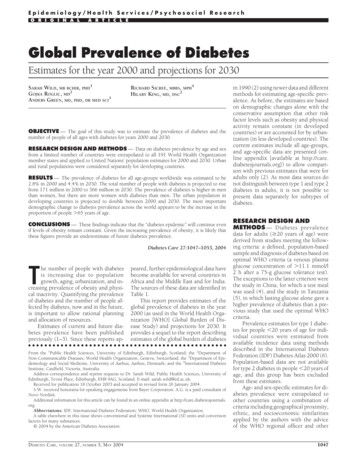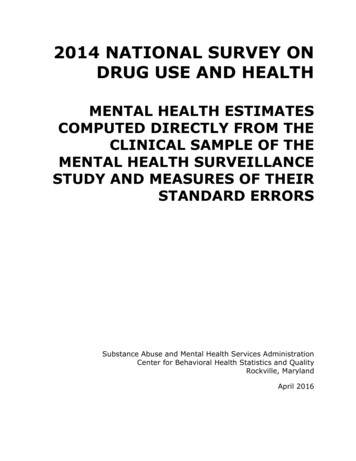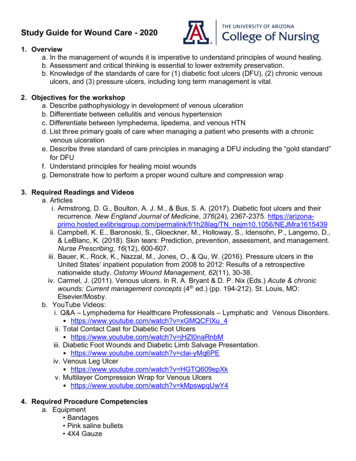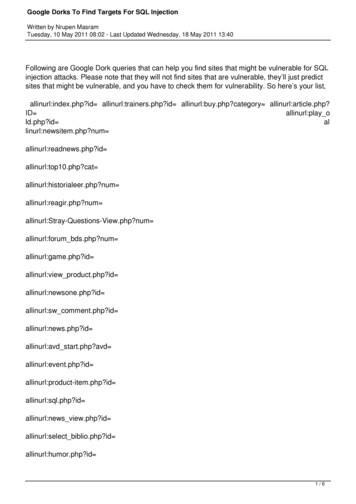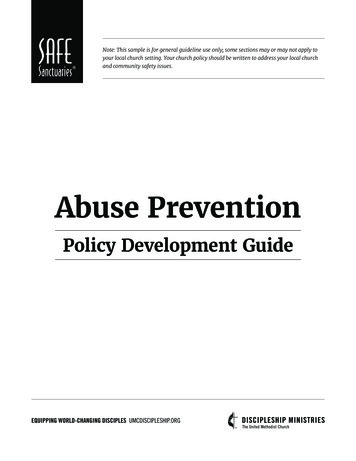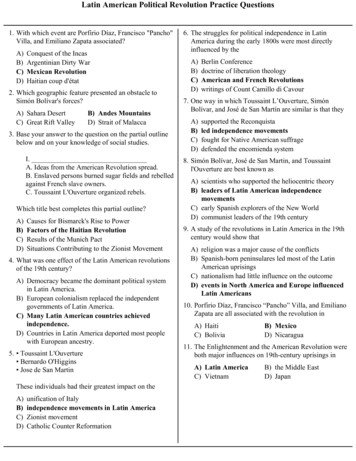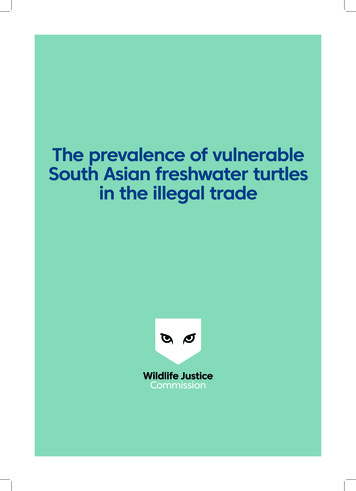
Transcription
The prevalence of vulnerableSouth Asian freshwater turtlesin the illegal trade
The prevalence of vulnerableSouth Asian freshwater turtlesin the illegal tradeThe illegal trade in freshwater turtles and tortoisesfor pets is widespread and is increasingly characterised as transnational, organised wildlife crime. Itposes a substantial threat to numerous species,many of which are already critically endangered.The demand to own live wildlife is often coupledwith a desire for rarer and harder to obtain speciesand is particularly prevalent for freshwater tortoises and turtles as exotic pets, the latter having become one of the most threatened vertebrate groupsglobally.1As part of the Wildlife Justice Commission’s (WJC)mission to disrupt and help dismantle transnational criminal networks, the organisation sought totackle the freshwater turtle and tortoise trade inAsia, which is particularly prevalent in this region.Operation DragonBetween January 2016 and January 2018, theWJC conducted Operation Dragon focused on criminal networks operating in the illegal trade inlive birds, reptiles, turtles, tortoises and primates,which are in high demand for the live pet tradeacross South and South-East Asia. Over the past 10years with 100,000 turtles seized and no majortargets arrested, the WJC decided to focus on previously untouched networks and to identify andexpose the corruption that facilitates the trade.This focused and closely co-ordinated investigation resulted in the arrest of 30 high-level personsof interest across Malaysia, India and Bangladesh,of which five have been given custodial sentences1- Source: Turtles in Trouble. The World’s 25 Most EndangeredTortoises and Freshwater Turtles – 2018. Full link on pdf onlineat www.wildlifejustice.organd one remains outstanding on INTERPOL’s RedNotice.During this two-year investigation, the WJC operatives were offered and often directly sighted several species of tortoises and freshwater turtles,allowing for corroboration of species for sale. Aspart of the evidence collection, all such instancesand the species, quantity and value of these offerswere documented. During Operation Dragon, anestimated minimum of 20,400 specimens derivingfrom 16 species of tortoises (four) and freshwaterturtles (12) listed in Appendix I and II of the Convention on International Trade in EndangeredSpecies of Wild Fauna and Flora (CITES) were offered for sale. While this approach made it possibleto quantify the scope of illegal trade, it also meantthat species of concern not commonly seen on theinternational market could be detected.Entry pointThe WJC undertakes undercover, intelligence-ledinvestigations and will often engage directly withtraders and brokers as prospective buyers.Using intelligence and analysis of social media,the WJC identified a network of Indian males based in Chennai and Kuala Lumpur engaged in thetrafficking, primarily in CITES Appendix I-listedspecies such as Black Spotted Turtles and IndianStar Tortoises (Appendix II). However, the authorsalso detected the emergence of several other lessfrequently encountered species in trade duringthe investigation. The WJC seeks to substantiate3http://wlr.pdf.
offers of products for sale made online or via mobile messaging by arranging meetings to view theproducts, and to discuss purchase. All engagements with traders are recorded, transcribed anddocumented for evidential purposes. To contextualise investigative findings, the WJC also undertook several desktop reviews to understandthe occurrence of these species in trade.Investigative findingsSome of the wildlife traders engaged with duringthe course of the investigation in India and Malaysia were trafficking species of South Asian fresh-water turtles, such as Red-crowned Roofed Turtlesand Three-striped Roofed Turtles (Images 1 & 2) aswell as other popular, well-recognised species onthe market such as Black Spotted Turtles. Whilethe number of these turtles offered for sale during the investigation is relatively low in comparison to other species (Table 1), there is concerngiven their endangered status, with any removalfrom the wild having a significant impact on theirability to recover. For example, Black SpottedTurtles, which are considered endangered, featured significantly during the investigation and havebeen included for comparative purposes in Table 1.Table 1. Species and number of South Asian freshwater turtles offered to the WJC (2016-2018),with status and protection levelsNo. of individuals offeredto the WJCSpeciesDistributionIUCN StatusCITESAppendixWildlifeProtectionAct, IndiaAssam Roofed TurtlePangshura sylhetensisBangladesh, IndiaEndangered (Bangladesh),Critically Endangered(India)Appendix IISCH.I125Black Spotted TurtleGeoclemys hamiltoniiBangladesh, India,Nepal, PakistanEndangered (Bangladesh),Vulnerable (India)Appendix ISCH.I7,342Brown Roofed TurtlePangshura smithiiBangladesh, India,PakistanNear ThreatenedAppendix IINot Listed265Red-crowned Roofed TurtleBatagur kachugaBangladesh,central Nepal,north-east IndiaCritically EndangeredAppendix IISCH.I306Three-striped Roofed TurtleBatagur dhongokaBangladesh,north-east IndiaCritically Endangered(Bangladesh) andEndangered (India)Appendix IINot Listed172It was noted that traders would place an emphasis on a species’ rarity on the market. This wassubstantiated to the WJC by a trader based inMalaysia, who was known to source products fromIndia, claiming he had many buyers from Hong4Kong and Thailand who sought Red-crownedRoofed Turtle and Three-striped Roofed turtlespecimens on account of their rarity and that hehad stocks of this species available for sale.
Image of Red-crownedRoofed Turtle providedby a trader to the WJCvia Facebook Messengerin October 2016.Image of Threestriped RoofedTurtle providedby a trader tothe WJC viaFacebookMessenger inOctober 2016. WJC WJCConversely, it appears that while the WJC observed these four species of freshwater turtles beingoffered for sale covertly, it is apparent that theyare seldom reported as being seized from trade, asis illustrated in Table 2 which records reported seizures between 2014 and 2017 across Asia according to open source research. It also highlightshow frequently Black Spotted Turtles are seizedfrom trade in comparison. This disparity betweenwhat is being documented in underground tradecompared to the number recorded in illegal trademay mean that current efforts by law enforcement agencies are not sufficient to detect suchspecies in illegal consignments. Furthermore, according to the CITES Trade Database, none of these four species has featured in legal trade between2014 and 2017, with fewer than 15 individualsrecorded for 2013.Table 2. No. of individuals seen in trade by the WJC (2016-18) compared to seized from trade (2014-17)SpeciesTotal No. of individualssighted / offered to the WJC2014201520162017Total No. of individualsseized from tradeAssam Roofed TurtlePangshura sylhetensis12500000Brown Roofed TurtlePangshura ned Roofed TurtleBatagur kachuga3060012728Three-striped Roofed TurtleBatagur dhongoka17200000Black Spotted TurtleGeoclemys hamiltonii5
Motivating factorsThese species appear to command a higher pricethan other more commonly traded species such asBlack Spotted Turtles. Consequently, smaller consignments can be transported more easily and stillyield a healthy profit, as this could require lesscomplicity of corrupt officials, keeping costs low.During the investigation, the WJC collected over200 different data points on prices of species offered for sale, the median price per head for BlackSpotted Turtles was calculated to be USD 110, compared to USD 1,150 for a Three-striped RoofedTurtle or USD 1,700 for a Red-crowned RoofedTurtle.The occurrence of these species on the international markets in Thailand, Malaysia and Hong Kongappears to be rarely reported. While some literature exists in relation to the threatened status of thespecies, there is little published research and/or sufficient data supporting this. However, WJC wasfrequently offered these species during the investigation, albeit not to the extent of other, better-known species. Of note is that the rarity of these species is cited as a selling feature, facilitated bythe above factors, which may be aiding crime. Thisdesire is further compounded by harder to obtainspecies, where “the rarer the species the better”.This is likely to encourage an anthropogenic alleeeffect, where the value attributed to rarity may pre-cipitate the extinction of rare species. Rarity in thewild is a particularly unique characteristic of thefreshwater turtle and tortoise trade - the criticallyendangered Ploughshare Tortoise Astrochelys yniphora likely qualifies as testament to this phenomenon.Conclusion and RecommendationsThe fact that these species of South Asian freshwater turtles are being targeted for internationalmarkets such as Hong Kong and China, with criminal networks from Thailand and Malaysia facilitating the trade is great cause for concern giventheir fragile status in the wild. This briefing papershould form sufficient basis to direct further research to assess the extent to which these speciesare in demand at an international level. This willassist in the formulation of recommendations totackle trade to prevent these species being furtherthreatened and foster closer collaboration betweenrelevant countries. It will also provide much neededdata to update assessments of population levels inthe wild.Of further note is that the Three-striped RoofedTurtle and the Brown Roofed Turtle, despite beingthreatened, are not included in India’s Wildlife Protection Act, 1972 (Table 1). As a matter of urgency,wildlife agencies such as the Indian Forest Serviceshould consider including them in the law in orderto prevent further exploitation of legal loopholes.Prepared by Sarah Stoner, Senior InvestigationsManager, Wildlife Justice Commission6
Wildlife Justice Commission7
www.wildlifejustice.org#wildlifejusticeTel: 31 70 205 1050info@wildlifejustice.org
lr.pdf. 4 offers of products for sale made online or via mo-bile messaging by arranging meetings to view the products, and to discuss purchase. All engage- . Roofed Turtle provided by a trader to the WJC via Facebook Messenger in October 2016. Image of Three- striped Roofed Turtle

